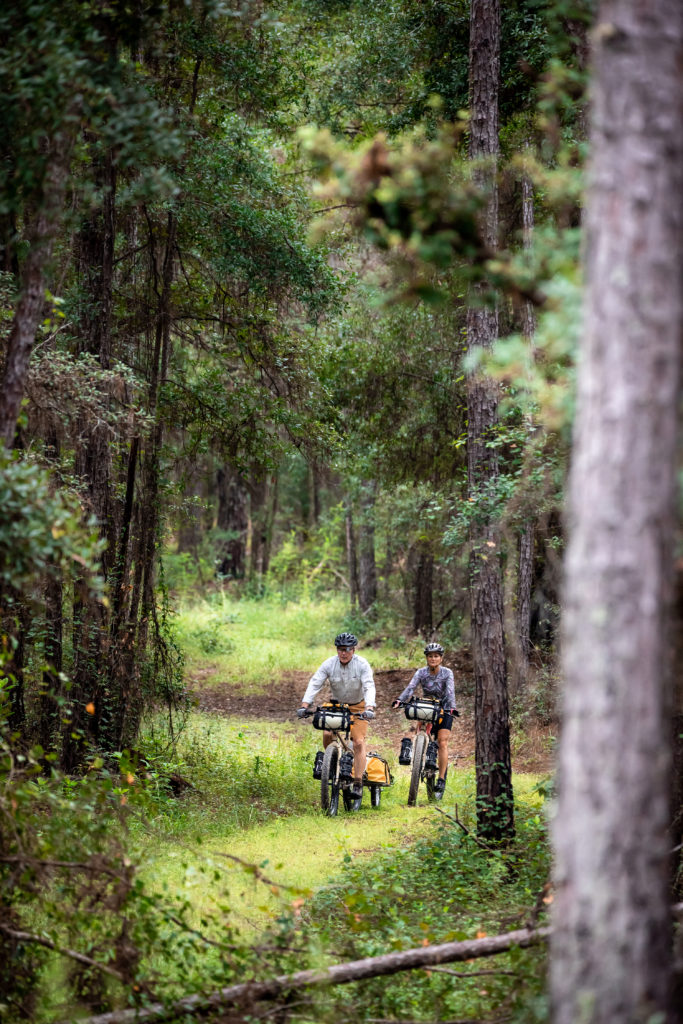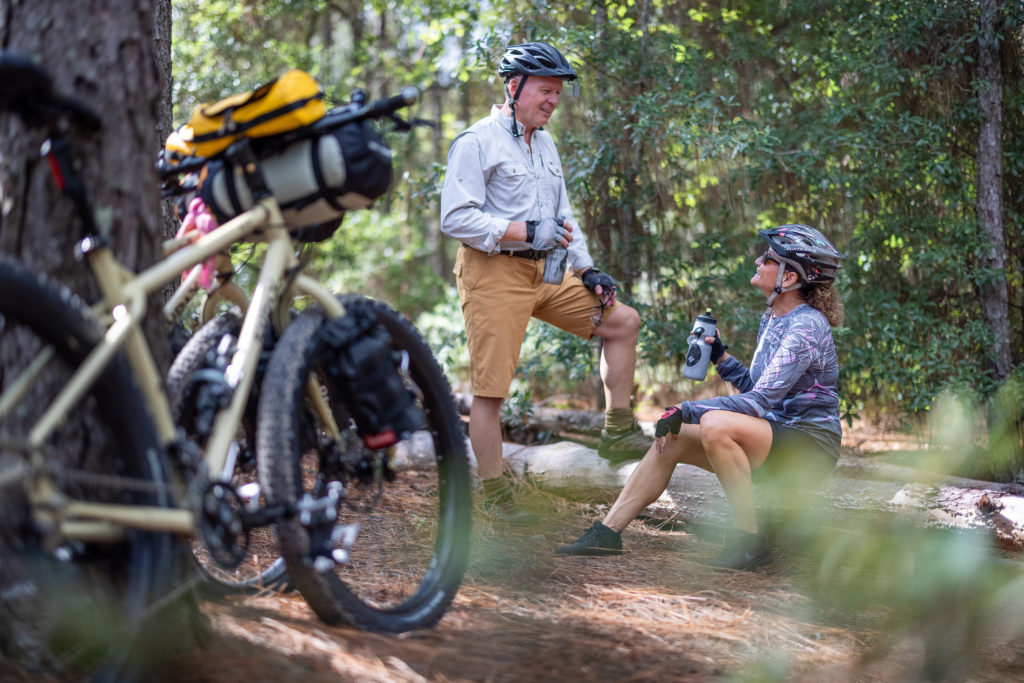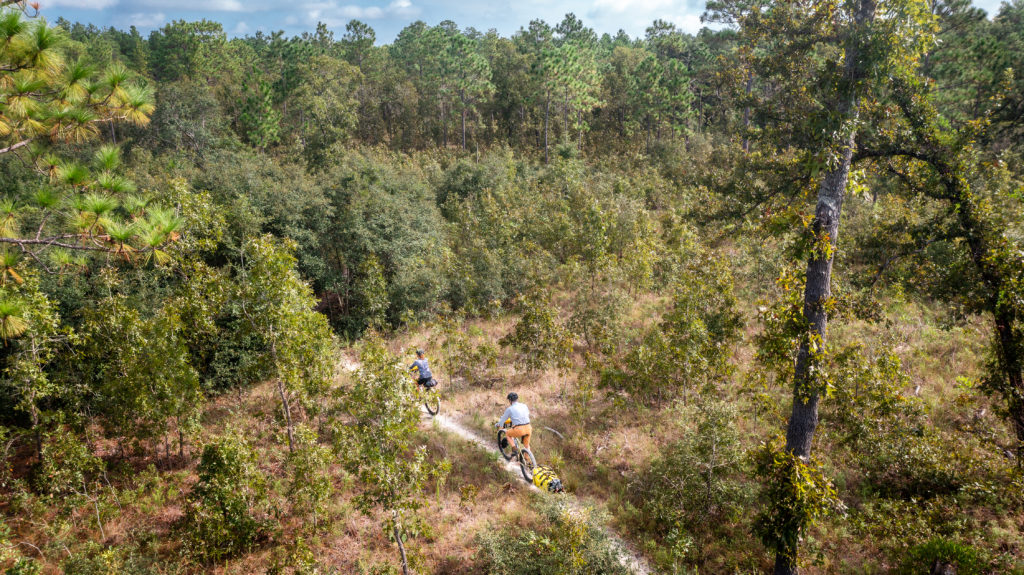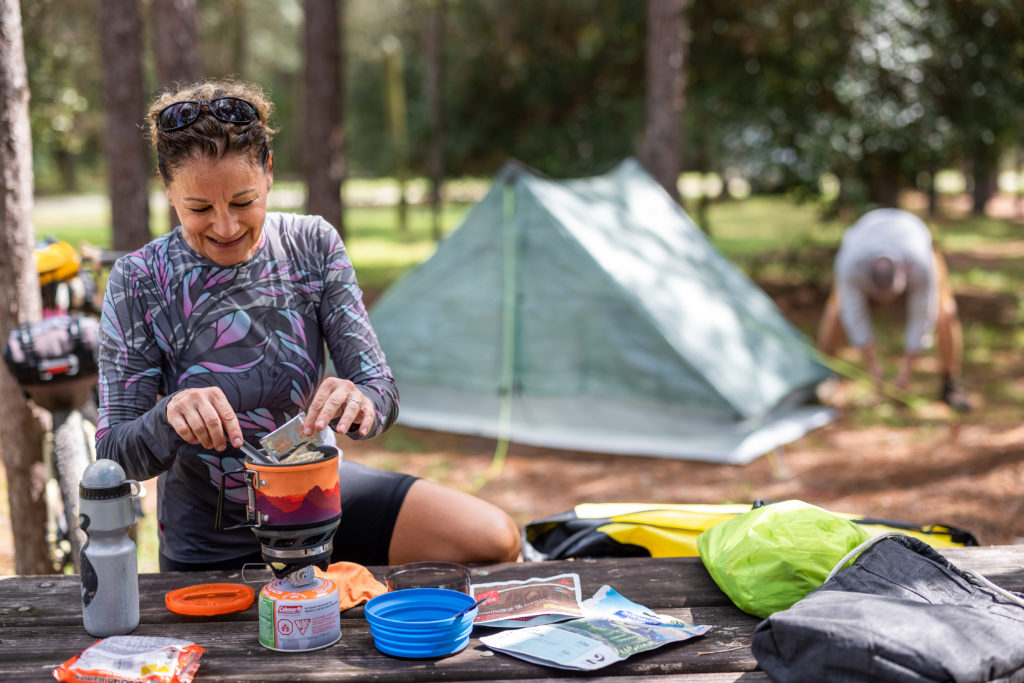Bikepacking while carrying minimalist camping gear, sometimes called “dirt touring,” provides off-the-beaten-path life experiences.
 If you’re looking for been-there, done-that, still-doing-it advice on bikepacking, say hello to Ocala residents Gary and Marlene Read. Need their bona fides? Originally from the Midwest, the Reads began taking bikepacking trips in 2013. To date, they have bikepacked in 13 different states. And, oh, they bikepacked from the Canadian border to the Mexican border.
If you’re looking for been-there, done-that, still-doing-it advice on bikepacking, say hello to Ocala residents Gary and Marlene Read. Need their bona fides? Originally from the Midwest, the Reads began taking bikepacking trips in 2013. To date, they have bikepacked in 13 different states. And, oh, they bikepacked from the Canadian border to the Mexican border.
“Marlene and I have always been active—hiking, trail running, ultra-marathons, kayaking and biking. Our early biking activities were weekly rides, picnic rides and other local destination trips. And we began to appreciate our bikes more as modes of transportation than just recreational toys,” says Gary, who retired from manufacturing management in 2018. “My first solo long-distance bike ride was a 185-mile trip across Michigan to visit my younger daughter in her senior year at college. I covered unfamiliar rural routes during the day and stayed in town motels on two nights. That two-and-a-half-day trek sparked something in me. It was like seeing, experiencing everything in a whole new way. And I wanted to share that experience with Marlene.”
In 2014, the couple found what they were looking for in the Great Allegheny Passage. The 150-mile nonmotor paved trail is on a defunct rail bed that follows a river across Pennsylvania from Pittsburgh to Cumberland, Maryland.
 “So off we went to bikepack on the Great Allegheny Passage, a 300-mile round trip. Our rides included beautiful river views, crossing green valleys on iron bridges, going through mountains in tunnels and passing historic sites,” shares Gary, smiling. “We’d ride for a couple of days then stay in some little towns along the way to enjoy the local areas. We visited museums, area attractions, went kayaking, listened to local live bands and ate where the locals ate.”
“So off we went to bikepack on the Great Allegheny Passage, a 300-mile round trip. Our rides included beautiful river views, crossing green valleys on iron bridges, going through mountains in tunnels and passing historic sites,” shares Gary, smiling. “We’d ride for a couple of days then stay in some little towns along the way to enjoy the local areas. We visited museums, area attractions, went kayaking, listened to local live bands and ate where the locals ate.”
Marlene, a certified personal trainer, says of the experience, “By the end of that two-week trip, I definitely had the bikepacking bug. I didn’t want to go home. I didn’t want it to end.”
Following the Great Allegheny Passage trek, the Reads evolved from spending nights in motels to more self-supported bikepacking, carrying their own camping gear and food. And while a 300-mile round trip would’ve been enough for most people, the Reads are not most people. In 2018, they took on the challenge of the Great Divide Mountain Bike Route (GDMBR). From the Canadian border to the Mexican border, this is definitely not a Sunday afternoon bike outing.
“We began in Eureka, Montana, just on the U.S. side of the border with Canada and finished in Columbus, New Mexico, right on the Mexican border,” explains Gary. “We pedaled 2,500 miles through very sparsely populated mountainous areas, carrying everything we needed for camping and cooking, and clothing for wet and dry weather that could range from 40 to 95 degrees on any given day.”
Marlene adds, “The whole trip took us three months and three days. We loved experiencing life in details we generally overlook in our daily lives. And we had interactions with local people that you just don’t have driving 70 miles an hour through an area. The GDMBR experience was transformational and reinforced what is truly important in life.”
Gary concurs, saying, “There’s something about being out on these long bikepacking trips that retunes us to find laughter, joy and excitement as easily as when we were children.”
And the Reads have plans for more bikepacking adventures. Next possible trips are the Katy Trail in Missouri and the Natchez Trace, which goes through Tennessee, Alabama and Mississippi.
 Biking Up
Biking Up
As practical experts, the Reads have some great advice to share. They agree that when it comes to bikes, start with what you have and/or match the bike to what kind of riding you want to do. When it comes to off-road bikepacking, they recommend mountain bikes or expedition bikes. The Reads used mountain bikes on the Great Allegany Passage trip and Surly ECR expedition bikes on the GDMBR.
“Many people use mountain bikes for bikepacking. Generally speaking, if your bikepacking trips are minimalist, a couple of days of fast rides, then a mountain bike is the right one for you,” notes Gary. “If your trips are more days and nights with more gear, then an expedition bike would provide advantages. They have larger volume tires for better rolling on dirt, sand, gravel and just about any kind of ground that you’d encounter. Expedition bikes have more frame strength; the frame geometry and attachment bosses better facilitate long-term load hauling.”
According to the Reads, two rookie mistakes are too high tire pressure and too low seat height.
“Don’t pump your tire pressure up to the number on the sidewall. That number is the maximum safe pressure but not the optimal pressure for low-rolling resistance, good handling, braking and tire longevity at your particular weight,” explains Gary. “It’s probably not too soft until you can see the sidewall squishing out while riding.”
He stresses that softer tires roll better over various terrains.
According to canyon.com, which offers a rough guide by the type of bike, “Dialing in your bike’s tire pressure may be the single biggest improvement that you can make to your riding experience. Pressures can vary greatly depending on a number of factors, so it’s useful to have some outside parameters.”
The guide goes on to offer, “Manufacturers usually have a maximum pressure embossed on the wall of the tire. Inflating tires over these maximum pressures is not advised. The optimum pressure, though, is likely to be less than the max shown.”
When it comes to correct bike seat height, Marlene notes, “Most beginners think pedaling is too difficult but that’s usually because their seat is too low. Get the seat raised to where each leg is almost straight at the bottom of a stroke.”
They agree that standard bike helmets are sufficient for bikepacking.
 Trip Packing
Trip Packing
Bikepacking bags include those that are attached to the handlebar, seat/saddle and frame of the bike. Many riders also carry waterproof backpacks and have handlebar mounts for cellphones, primarily for navigation. The key to bikepacking gear is to think minimalist efficiency. Into those bags, a rider packs such things as clothes, food, camping gear, water filter, first aid and bike repair tool kits. And weight matters.
“The biggest mistake people make is packing way too much stuff. Even though we already knew better, on the GDMBR we still shipped back stuff we didn’t really need every week when we passed through a town,” admits Gary.
With a nod, Marlene says, “My rule is that everything I pack should have at least three purposes. We’re just so spoiled and attached to things in our homes that we don’t realize how much stuff we have that we really don’t need. But when you’re carrying that stuff on a bike, you quickly learn what you really do need and pare it down to that.”
Some bikepackers use single-wheeled trailers, pulled behind the bike.
“Trailers are good for taking weight off the bike, especially if you’re riding with a partner. Then you can store a lot of your shared stuff in it,” says Gary.
 Planning Ahead
Planning Ahead
The Reads’ evolution from long neighborhood rides to destination rides to overnight rides is a good example of how to transition into bikepacking trips.
“Plan your first bikepacking trip on daily mileage that’s half as many miles as your home day rides. Start with an overnighter or weekend trip. Go somewhere nearby, like a state park, with a designated campground; check ahead to make sure if you need to make campground reservations,” Gary suggests. “This will be a learning-curve trip about gear weight, terrain, missed turns, map errors, pack issues, weather and previously undetected maintenance issues.”
Marlene chimes in with a knowing grin, “Every trip is a learning curve. You just have to stay open to that and not expect any trip to go perfectly as planned.”
Going solo is fine but having a biking partner is not a bad idea and also adds to the fun of bikepacking.
“Riding with others is safer and provides more options for problem solving,” says Gary. “If some gear can be shared, such as a tent, cook system and tools, then there is more opportunity for weight reduction per person.”
“Besides, the fun memory of the experience is better when it’s shared,” Marlene adds.
Once you’re ready to venture into more adventure, there is information available to plan a longer bikepacking trip.
“The Adventure Cycling Association publishes digital and paper maps for numerous routes for bikepacking, such as the GDMBR. Because these routes are frequently traveled by cyclists, you’ll find small stores, restaurants, motels and campgrounds that are familiar with bikers’ needs,” Gary explains. “I recommend beginners stick with established routes before trying to cobble together a unique route. I’ve yet to find one map source that includes rail trails, safety paths, wide road shoulders, dirt trails and gravel roads all on one product.”
The final piece of advice from the Reads is a simple one.
“Just go out and enjoy the outdoors,” Gary asserts. “Just getting out in the woods is good for our mental and physical health. And bikepacking can be a way to go more places under your own power than you might ever have imagined.”
Want To Know More About Bikepacking?
Gary & Marlene Read/awwventurus@yahoo.com
bikepacking.com
rei.com
adventurecycling.com
singletracksamurai.com






